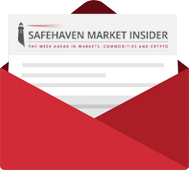Gold bears tirelessly repeat that deflationary periods are characterized by heightened demand for cash. For the United States, this means a strong US dollar.
Since the USD and gold are inversely correlated, the bears conclude that the gold bull market is over given that we have entered into a severe deflationary period.
This may seem like a strong argument but it does not withstand a more detailed analysis.
Although the inverse relationship between the US dollar and gold is true most of the time, there have been extended periods when both gold and USD appreciated in value. We only have to go back a few years to see a positive relationship between the two. Believe it or not, even in 2008, gold gained 5.8%, while the US Dollar Index gained 7.5%.
Today, most analysts who are bearish on gold believe that the US economy has entered into a deflationary recession similar to the Japanese lost decade of the 1990s. However, during the second half of the 1990s, when Japan was in the midst of a severe deflation, the Japanese yen fell dramatically by almost 50% as seen in the chart below.

Currency exchange rates during the period of competitive devaluation cannot have a meaningful effect on the behavior of gold. Excess supply of world fiat currencies will only move gold higher regardless of some currencies' fluctuations in relation to other currencies.
















